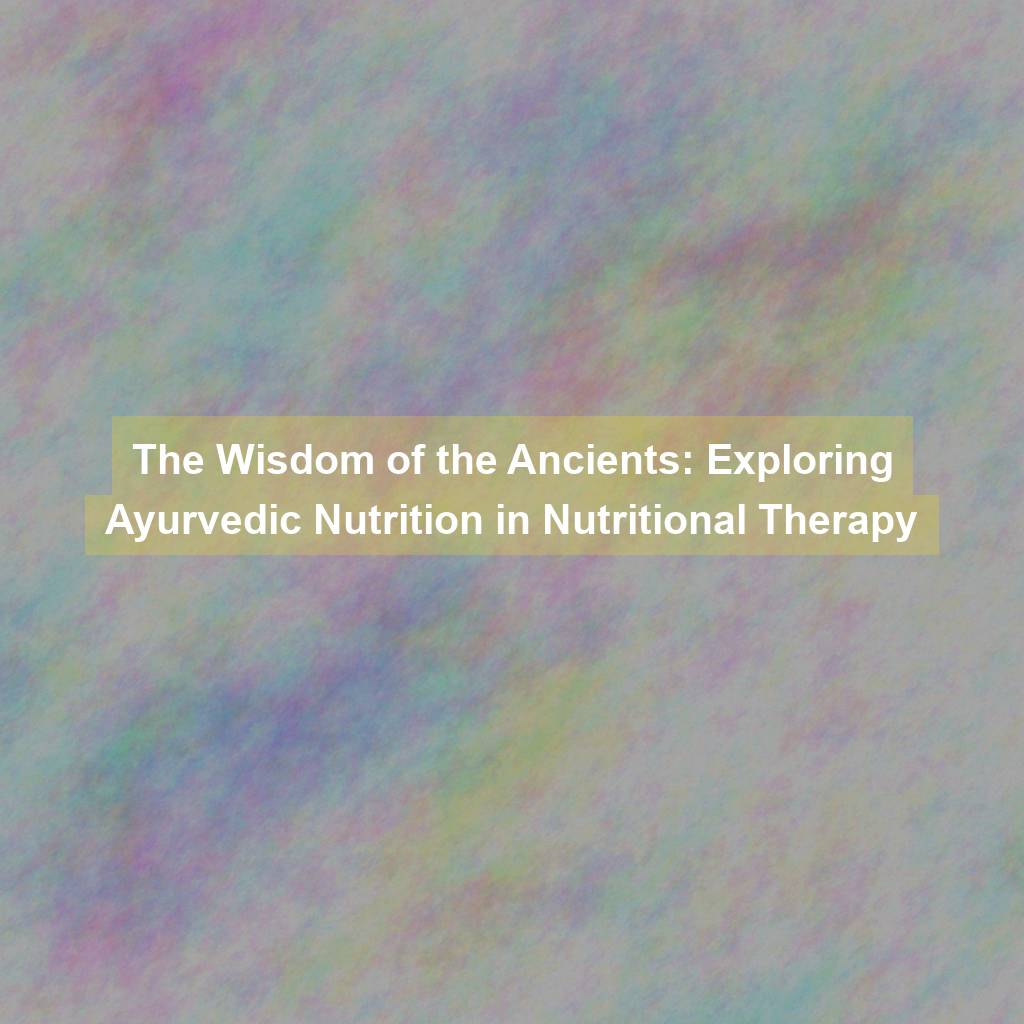You may not be aware that Ayurvedic nutrition, an ancient system of healing from India, offers a unique approach to nutritional therapy that goes beyond just the physical aspect of food.
Have you ever considered how the wisdom of the ancients can provide valuable insights into creating a balanced and holistic approach to nourishment?
As you explore the principles of Ayurvedic nutrition in the context of modern nutritional therapy, you will uncover a fascinating world of interconnectedness between food, body, mind, and spirit that has the potential to revolutionize your approach to wellness.
Origins of Ayurvedic Nutrition
Explore the ancient origins of Ayurvedic nutrition, which have been shaped by centuries of traditional knowledge and cultural practices. The foundation of Ayurvedic nutrition lies in the belief that the universe is composed of five elements: space, air, fire, water, and earth. These elements combine to form three doshas, or energies, known as Vata, Pitta, and Kapha, which are present in varying degrees in every individual. The origins of Ayurvedic nutrition can be traced back over 5,000 years to ancient India, where sages and practitioners developed this holistic approach to health and wellness.
Ayurvedic nutrition is deeply rooted in the principles of balance, harmony, and moderation. It emphasizes the consumption of fresh, whole foods that are in season and locally sourced. The practice also encourages mindful eating, recognizing the interconnectedness of food, digestion, and overall well-being. Additionally, Ayurvedic nutrition considers the unique constitution of each person and provides tailored dietary recommendations to support individual health.
Understanding the ancient origins of Ayurvedic nutrition provides insight into the time-tested wisdom that continues to guide nutritional therapy practices today. By embracing these foundational principles, individuals can cultivate a deeper understanding of their own health and well-being.
Doshas and Nutritional Imbalance
The balance and harmony of your doshas play a crucial role in maintaining optimal health and well-being through Ayurvedic nutrition. According to Ayurveda, there are three doshas: Vata, Pitta, and Kapha, each representing different elements and functions within the body. When these doshas are in balance, you experience good health, but when they become imbalanced, it can lead to various health issues, including those related to nutrition.
An imbalance in your Vata dosha, for example, may manifest as digestive problems, poor nutrient absorption, and irregular eating habits. On the other hand, an aggravated Pitta dosha can lead to excessive heat in the body, causing inflammation and sensitivity to certain foods. Similarly, an imbalance in Kapha dosha may result in sluggish digestion, weight gain, and cravings for unhealthy foods.
Understanding your unique doshic constitution and identifying any imbalances can help tailor your nutritional choices to restore equilibrium. By incorporating specific foods, spices, and cooking methods, you can support your doshas and address any nutritional imbalances, promoting overall health and well-being. Ayurvedic nutrition aims to bring the doshas back into harmony, allowing you to thrive with a balanced and nourishing diet.
Ayurvedic Dietary Guidelines
As you consider your doshic constitution and any imbalances, it’s important to adhere to Ayurvedic dietary guidelines to support your overall well-being and promote doshic equilibrium. In Ayurveda, food is considered medicine, and the way you eat can have a significant impact on your health.
One key principle is to eat according to your dosha, focusing on foods that help balance your specific constitution. For example, if you’re predominantly Vata, incorporating warm, nourishing, and grounding foods can help pacify Vata’s cold, light, and dry qualities. Similarly, if you’re primarily Pitta, favoring cooling, hydrating, and calming foods can help counter Pitta’s hot, sharp, and intense nature. And for Kapha individuals, emphasizing warm, light, and stimulating foods can assist in balancing Kapha’s heavy, slow, and steady attributes.
Additionally, Ayurvedic dietary guidelines emphasize the importance of mindful eating, such as being present during meals, chewing food thoroughly, and avoiding overeating. Eating fresh, seasonal, and organic foods, as well as incorporating the six tastes (sweet, sour, salty, pungent, bitter, and astringent) into each meal, are also essential aspects of Ayurvedic nutrition.
Integrating Ayurvedic Principles in Therapy
Consider integrating Ayurvedic principles into your therapeutic approach to promote holistic well-being and doshic balance. By incorporating Ayurveda into your nutritional therapy practice, you can provide a more comprehensive and personalized approach to healing. Start by assessing your clients’ doshas, or mind-body constitutions, to understand their unique needs and imbalances. Then, tailor your dietary recommendations and lifestyle suggestions to align with their specific doshic requirements.
Integrating Ayurvedic principles also involves emphasizing mindful eating practices, such as eating in a peaceful environment and being present during meals. Encourage your clients to savor each bite and to be mindful of their body’s signals of hunger and fullness. Additionally, consider incorporating Ayurvedic herbs and spices into your recommendations, as they offer both therapeutic and flavor-enhancing properties.
Furthermore, Ayurveda highlights the importance of establishing healthy daily routines, known as dinacharya, to support overall well-being. By integrating these principles into your therapy, you can help your clients achieve balance and harmony on physical, mental, and emotional levels. Remember, the integration of Ayurvedic principles should be approached with respect and a deep understanding of their application in the context of individual needs and conditions.
Ayurvedic Superfoods and Healing Spices
Explore the myriad benefits of incorporating Ayurvedic superfoods and healing spices into your nutritional therapy practice to enhance holistic well-being and doshic balance.
Ayurvedic superfoods such as ghee, a clarified butter, are renowned for their healing properties. Ghee is considered a rich source of healthy fats and is believed to lubricate the connective tissues and promote flexibility in the body.
Additionally, incorporating healing spices like turmeric, ginger, and cumin can provide anti-inflammatory, digestive, and immune-boosting benefits. Turmeric, with its active compound curcumin, is known for its potent anti-inflammatory and antioxidant properties. Ginger is valued for its digestive support and anti-nausea effects, while cumin aids in digestion and enhances nutrient absorption.
These superfoods and spices can be tailored to suit specific doshic imbalances, making them a valuable addition to your nutritional therapy toolkit. By integrating these Ayurvedic superfoods and healing spices into your practice, you can offer personalized and holistic support for your clients’ well-being.
Conclusion
In conclusion, exploring the wisdom of Ayurvedic nutrition offers valuable insights into creating a balanced and personalized approach to nutritional therapy.
By understanding the origins of Ayurvedic nutrition, the role of doshas, and following Ayurvedic dietary guidelines, one can integrate these principles into therapy for improved holistic health.
Incorporating Ayurvedic superfoods and healing spices further enhances the effectiveness of this ancient practice in promoting overall well-being.







